Naples is a city that has two distinct levels. On the surface, you can see magnificent buildings and palaces close to each other. However, underground, there are numerous tunnels carved into the rock over the centuries. These tunnels have served as storerooms, shelters, and even places of worship. In this article, you will discover the most beautiful itineraries and guided tours to explore underground Naples.
Table of Contents
The routes of Naples Underground: what and how many there are
Naples, the city we see today, was constructed using the tuff, a type of volcanic rock present underground over the centuries. While the quarried rock became the raw material for buildings on the surface, the voids left by the extraction created solid underground structures. These spaces have been used in diverse ways, including places of worship, air-raid shelters, wells, and cisterns.
ORGANISE YOUR TRIP TO NAPLES
Save money on your trip to Naples with the Naples Pass and enjoy access to popular attractions like the underground city tour and the Catacombs of San Gennaro, along with unlimited public transport.
Stay connected throughout Italy by getting an Airalo eSim online for reliable data and phone coverage. Don’t forget to secure your Heymondo travel insurance for peace of mind and be covered for any surprises on your adventure!
Today, there are different routes to visit underground Naples. There are two routes known as Napoli Sotterranea (Underground Naples), recognised by two different public offices. One, recognised by the Demanio di Napoli, has the entrance from Via dei Tribunali and crosses the ancient Greco-Roman Aqueduct. The other, recognised by the Regione Campania, is under the Spanish Quarters with the entrance from Vico Sant’Anna di Palazzo.
Another evocative route through cisterns and air-raid shelters is the Bourbon Tunnel, managed by the Associazione Culturale Borbonica Sotterranea (Bourbon Tunnel Underground Cultural Association).
Over the centuries, the Neapolitan underground was also a place of worship and burial for early Christians. If you are interested in these itineraries, you can choose between the Catacombs of San Gennaro and the Catacombs of San Gaudioso. You can also visit the Cimitero delle Fontanelle (Fontanelle Cemetery), a former ossuary known for the cult of the ‘anime pezzentelle’.
Underground Naples with a visit to the Greco-Roman aqueduct
The first tour of Napoli Sotterranea (Underground Naples) is the one authorised by the Agenzia del Demanio and managed by the Associazione Napoli Sotterranea. The tour follows a 40-metre-deep route through the tunnels and cisterns of the ancient Greco-Roman aqueduct, passing among the World War II air-raid shelters.
Underground Naples is a tour through history. It starts with the first underground tuff quarries from the 3rd century BC, opened by the Greeks, and continues through the network of Roman aqueducts. During the guided tour, you can discover the workings of the Augustan-era aqueduct that supplied fountains and townhouses with water from the Serino River, 70 kilometres away.
When the Roman aqueduct and rainwater cisterns became insufficient for the city’s needs in the 16th century, the Neapolitan nobleman Cesare Carmignano built a new aqueduct, which remained in use until the 20th century.
Air-raid shelters, Nero’s theatre, and underground wine and garden in the Underground Naples tour
During World War II, Naples’ tunnels became air-raid shelters for Allied and German bombing raids. At the end of the tour in the Museo della Guerra di Napoli Sotterranea (Underground Naples War Museum), you can see graffiti on the walls and many war objects.
Last, you can also enter the remains of Nero’s Theatre, the ancient Greek-Roman Theatre of Naples, incorporated in the 15th century by a ‘basso’, a typical Neapolitan residential dwelling. Among the various activities run by the Associazione Napoli Sotterranea is the Vino Tufello, a wine aged in the tuff quarries, and the underground garden of the Orti Ipogei at a depth of 35 metres.
Napoli Sotterranea (Underground Naples)
Piazza San Gaetano, 68 – Via dei Tribunali
80138 Napoli
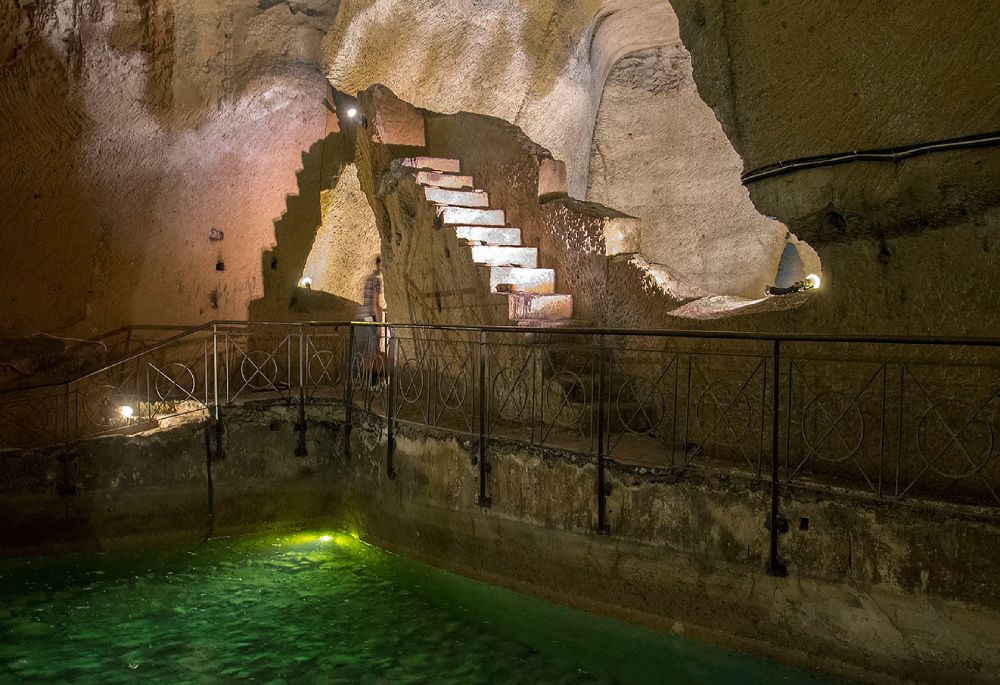
Underground Naples under the Quartieri Spagnoli
The second Underground Naples tour, under the Spanish Quarters, is recognised by Regione Campania and run by the Libera Associazione Escursionisti Sottosuolo. Like the previous one, it shows the underground Naples between aqueducts and air-raid shelters but in a different part of the city.
On this guided tour, you can see the cisterns of the aqueduct built by Cesare Carmignano to replace the former Roman waterworks and visit one of the many underground bomb shelters in Naples. During World War II, abandoned tuff quarries and old disused cisterns were used as shelters to shelter from Allied and German bombing.
This Naples Underground route passes under the historic centre and tells the story of Naples and its underground. The underground part of the city is still partly unexplored and under restoration for the disposal of debris and waste during the last century.
Napoli Sotterranea (Underground Naples)
Vico S. Anna di Palazzo, 52
80132 Napoli
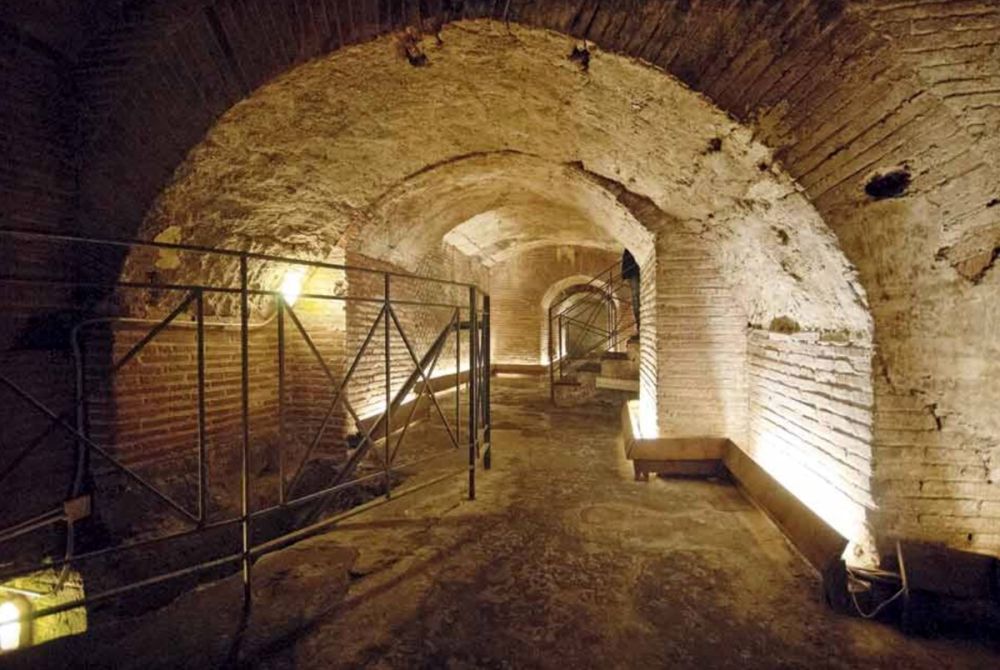
Bourbon Tunnel
The Bourbon Tunnel is a military tunnel commissioned by King Ferdinand II as an escape route from the Royal Palace to the sea. The original project was never completed, but the route ends almost on the seafront. Today, you can visit it with one of the tours of Associazione Culturale Borbonica Sotterranea (Bourbon Underground Cultural Association). The guided tour passes through tuff quarries and cisterns, an air-raid shelter and the Naples Municipal Court Depot with impounded car and motorbike wrecks.
Compared to the other routes of the Naples Underground, the Bourbon Tunnel has a different origin. Commissioned by King Ferdinand II, the project was abandoned due to technical difficulties and the unification of Italy. You can read more on my article on the Bourbon Tunnel.
What’s inside the Bourbon Tunnel
The tour starts from the historic Palazzo Serra di Cassano. It passes through cisterns and tuff quarries, used in the last century as an air-raid shelter for Allied and German bombings and as a court depository. Visiting the Bourbon Tunnel is a journey into the recent history of Naples.
Also, seeing the tuff quarries in person, with the rock entirely excavated by hand, is a unique experience. The ceilings are very high, and workers lowered themselves from above simply with ropes to extract the rock without any mechanical machinery.
The Bourbon Tunnel’s most famous attractions are the souped-up cars and mopeds seized from the Neapolitans. Engines that were thoroughly elaborated or invented from mechanical parts available on the market after the war and inventively assembled to create new original means of transport.
If you want to book more than one tour to visit different parts of the Naples Underground, the Naples Pass includes both a visit to the Bourbon Tunnel and the entrance to the catacombs.
Galleria Borbonica (Bourbon Tunnel)
Via Monte di Dio, 14 / Vico del Grottone, 4 / Via Domenico Morelli, 61 C
80121 Napoli
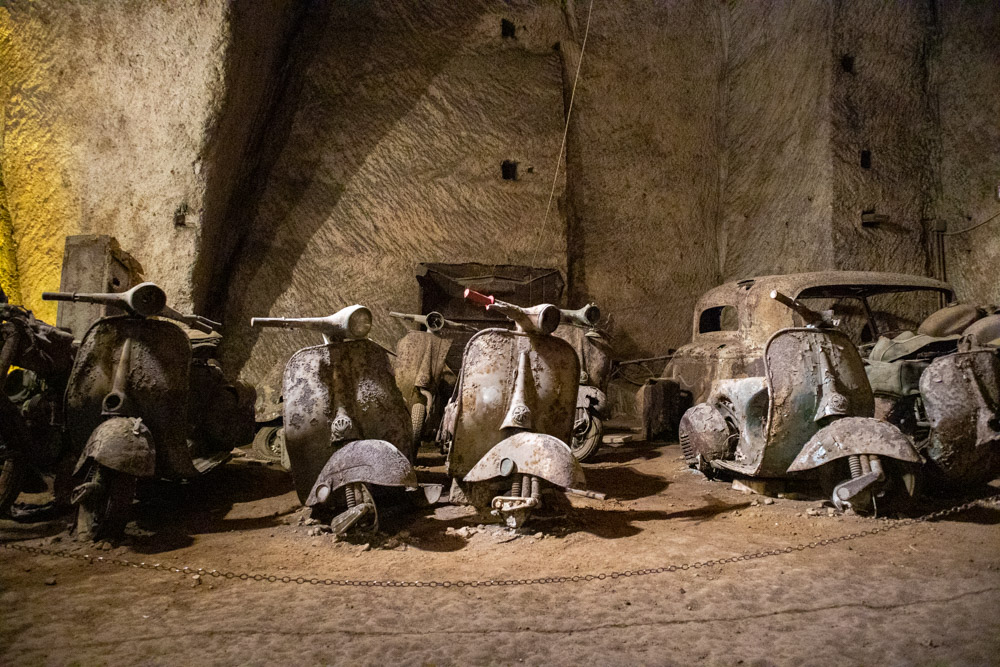
Catacombs of San Gennaro
The Catacombs of San Gennaro, an ancient burial site where the remains of the Neapolitan patron saint rested for a while. It is also the only site of its kind in the world that is entirely wheelchair accessible. In Naples, the relationship with the afterlife is part of everyday life. Devotion, rituals and dialogue with the dead are part of Neapolitan folklore and have always accompanied the city’s life, as you can discover on this guided tour.
The Catacombs of San Gennaro are on two non-overlapping levels. They house the first tomb of San Gennaro, an ancient burial in the upper catacomb and the Hypogean Basilica of St Agrippino in the lower catacomb. Unlike the Roman catacombs, the spaces are very large. Sometimes mass is still celebrated in the Basilica of St Agrippinus, dedicated to the first patron saint of Naples.
What’s on in the Catacombs of San Gennaro
The original core of the Catacombs of San Gennaro, the upper catacomb, was probably the tomb of a noble family, Roman nobles, who donated it to the Christian community. The guided tour tells how the expansion of the catacombs followed the transfer of the remains of San Gennaro in the 15th century.
The arrival of the saint’s remains made the upper catacomb a place of pilgrimage and a coveted burial site. At the time, the Catacombs of San Gennaro expanded with the Crypt of the Bishops, a new place to bury the city’s bishops, and a three-aisled underground basilica. The tour of the Catacombs of San Gennaro also passes through an impressive space with up to 6 metres high ceilings that house a baptismal font.
Keep your ticket at the end of the tour. It remains valid for 12 months to visit the Catacombs of San Gaudioso. If you want to visit different parts of the Naples Underground, the Naples Pass includes both entry to the catacombs and a guided tour of the Bourbon Tunnel.
Catacombe di San Gennaro (Catacombs of San Gennaro)
Via Capodimonte, 13
80100 Napoli
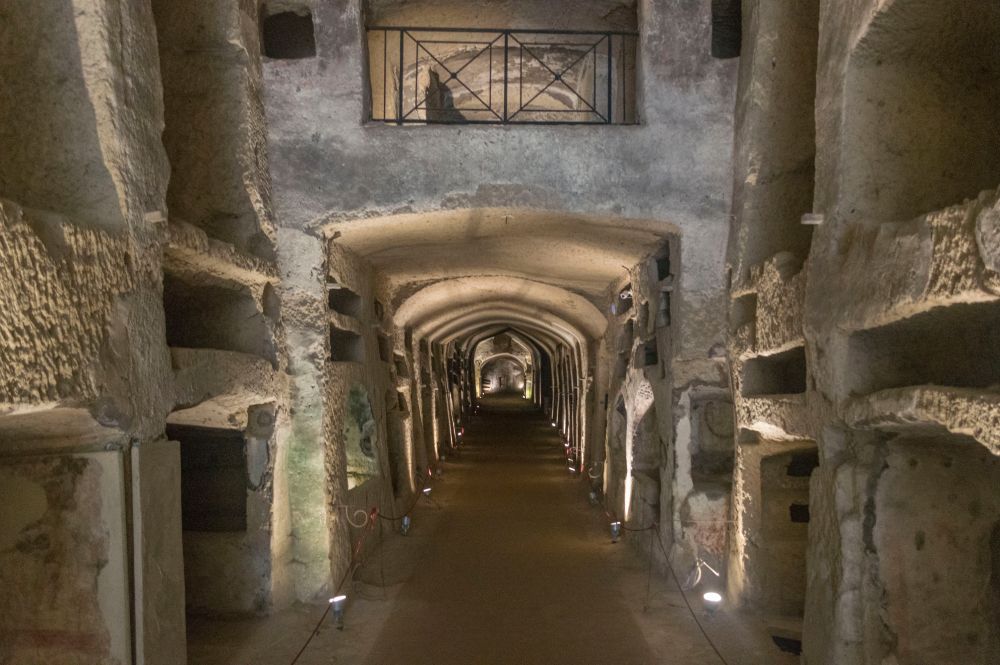
Catacombs of San Gaudioso
The Catacombs of San Gaudioso are the second largest in Naples, after the Catacombs of San Gennaro. However, the entire Sanità district was an ancient cemetery area, only parts of which have been brought to light. During the guided tour, you can see symbols of the early Christian age, such as fish, lamb, vine with branches, and frescoes and mosaics from the 15th and 16th centuries.
The entrance to the Catacombs of San Gaudioso is under the scenic Basilica of Santa Maria della Sanità, which is rich in Rococo decoration. The place became an object of worship following the burial of San Gaudioso, bishop of Abitine, Tunisia. According the legend, he arrived in Naples on board a ship without oars or sails, running from the Vandal invasion to not convert to Arianism.
Thanks to popular devotion, the early Christian underground cemetery developed into the current structure of the Catacombs of San Gaudioso. During the tour, however, you will discover that the size and rooms of the complex are uncertain. The catacombs underwent numerous transformations, including those necessary to build the Basilica of Santa Maria della Sanità above.
After visiting the Catacombs of San Gaudioso, you can keep your ticket for free access to the Catacombs of San Gennaro within 12 months. To save money and discover different areas of the Naples Underground, with the Naples Pass, you can access both the catacombs and the guided tour of the Bourbon Tunnel.
Catacombe di San Gaudioso (Catacombs of San Gaudioso)
Piazza Sanità, 14
80136 Napoli
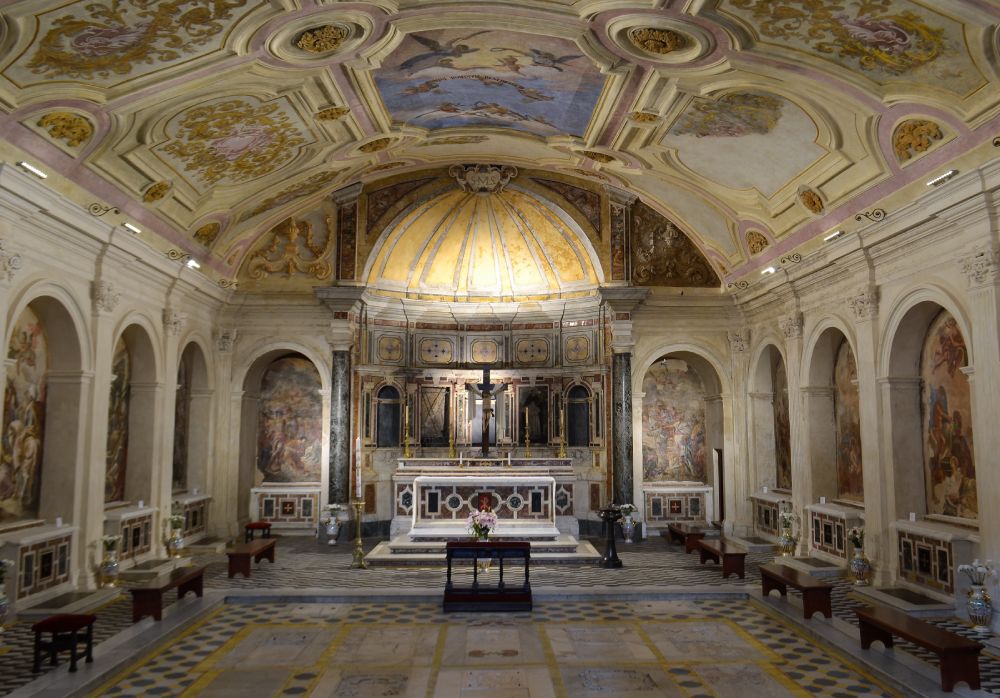
Fontanelle Cemetery
The Cimitero delle Fontanelle is an ancient cemetery in the Sanità district. It is famous for its enormous ossuary, in which the cult of the ‘capuzzelle’ is still practised to obtain lotto numbers from the deceased. Admission to the cemetery is free. However, I recommend you visit it with a guide to discover this unique place’s legends, anecdotes and curiosities. You must book the guided at least one day in advance because no guides are at the entrance.
The name of the Fontanelle Cemetery derives from the water springs, fontana, fontanella in Italian, once present in the area. Today, the cemetery is best known for the cult of the ‘anime pezzentelle’ in the over 3,000 square metre ossuary.
Inside the Fontanelle Cemetery are an unknown number of human remains piled up over the centuries. Before the 16th century, Catholics buried their dead in particular places inside churches, called ‘holy ground’ (terra santa). However, when no more space was available, the oldest remains were moved to abandoned tuff quarries such as the Fontanelle Cemetery.
The Cava delle Fontanelle officially became a cemetery in 1654, when the plague decimated the Neapolitans. It became necessary to find a burial place for more than 250,000 people out of 400,000. The graveyard also received bodies from the successive epidemics, famines, popular uprisings, earthquakes and eruptions of Vesuvius.
The last plague that saw the Fontanelle Cemetery as a designated burial place was the cholera epidemic of 1837. In the same year, a sanitary ordinance banned ossuaries from all parishes and confraternities in the city. All remains were then transferred to the Fontanelle Ossuary.
Cimitero delle Fontanelle (Fontanelle Cemetery)
Via delle Fontanelle, 80
80136 Napoli
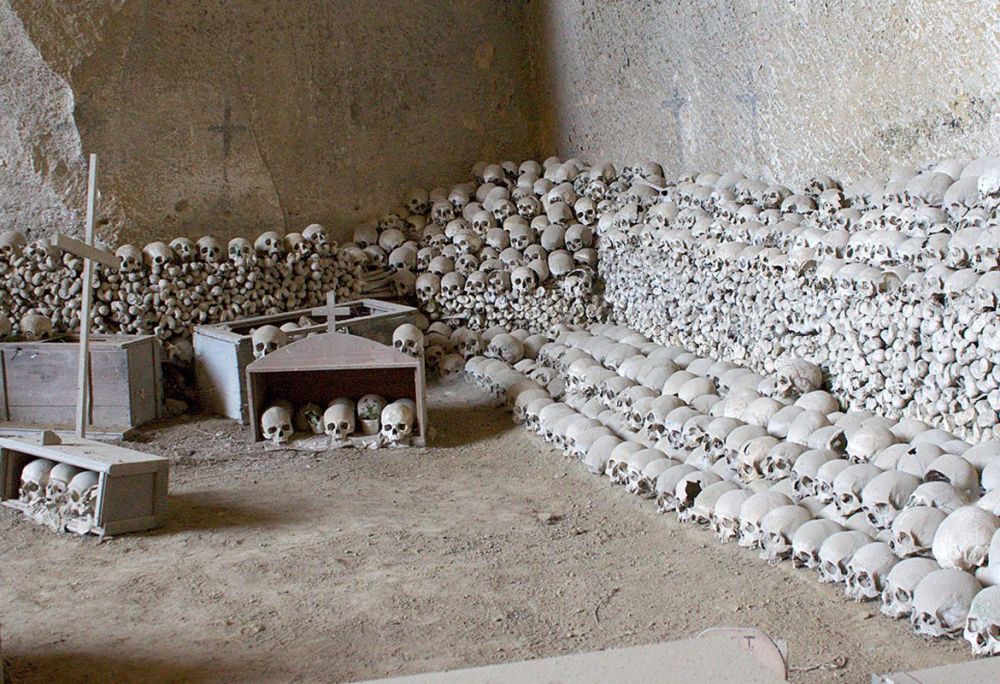
Where to stay in Naples
Naples boasts numerous accommodations, from hotels to seaside flats. With my frequent visits to Naples, I can suggest several options. For an authentic experience in the historic center, consider The Idyll Boutique Apartment in the Spanish Quarter. This charming flat features parquet floors and a fully equipped kitchen, conveniently close to major attractions. Alternatively, the upscale Relais Della Porta, situated on Via Toledo, places you a short distance from landmarks like the San Carlo Theatre. Last but not least, the Santa Chiara Boutique Hotel, located near the Dante metro stop, offers a continental or Italian breakfast to start your day.
As you can see, you are spoilt for choice among the itineraries of the Naples Underground. I suggest choosing the one that inspires you most to get started. Feel free to pose questions in the comment section or tell me about your experience with the Naples Underground.
